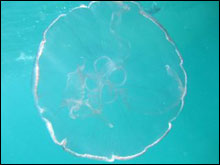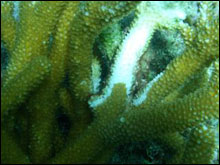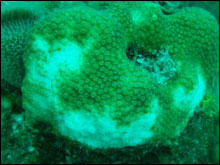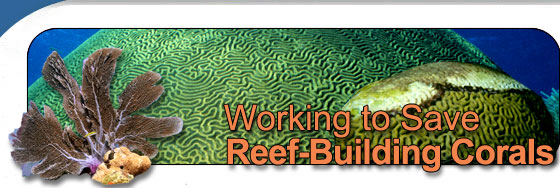Error processing SSI file
|
Mission Log Sept. 13, 2009
Kathy Morrow, Ph.D candidate
Auburn University
 |
| The common moon jellyfish (Aurelia aurita) was abundant in the Keys portion of the cruise. (Photo by Mike Henley) |
When you’re in the Dry Tortugas National Park you feel like you’re on the edge of the world. With the historic fort just in sight, and not a soul between you and the horizon, it makes one wonder what thoughts passed through the minds of those guarding this perilous stretch of water in the 1800s.
The Tortugas leg include some of the most anticipated dives of the cruise, promising coral reefs with archaically huge coral heads, massive parrotfish, hogfish and barracuda, and highly complex reefs from 6 to 200 feet.
Lending to the Tortugas mystery is an ever-changing sea, at times producing high seas, ripping current, and horrendous visibility, only to reveal placidly calm and crystal clear water with morning light. And as if to demonstrate the aptness of it’s name (tortuga meaning turtle), we saw a huge loggerhead turtle swimming the Fort Jefferson mote wall when we took an hour off to enjoy the sunset on dry land.
 |
| Staghorn coral (Acropora cervicornis) showing signs of white band disease. (Photo by Mike Henley) |
Nightly multibeam analysis has revealed the bathymetry of new sections of the Tortugas bank, providing evidence of undiscovered reefs, ship wrecks, and blue holes deep below the surface. We currently have one last team out diving late into the evening in an attempt to find and finish assessing our last station within the National Park.
To recap our time in the Tortugas, we arrived Friday evening, September 11, 2009, from Key West. On most days, three scientific dive teams are deployed each morning and afternoon to survey ~4 permanently marked sites. Survey teams consist of 3 individuals; a line tender, a coral counter/disease recorder, and a coral measurer. Since the inception of the Coral Disease and Condition Cruise in 1997, the traditional survey method included the identification of all coral species within the survey arc, with additional information recorded about corals afflicted with disease and/or bleaching. Over the past two years the survey method has been amended to include the collection of additional data on coral sizes and interactions with benthic organisms such as macroalgae, cyanobacteria, tunicates, zooanthids, sponges etc.
 |
| Mountainous star coral (Montastraea faveolata) showing sings of bleaching. (Photo by Mike Henley) |
As a graduate student at Auburn University and a NOAA Nancy Foster Scholar, I am particularly interested in the interaction data collected on corals and other reef organisms. My dissertation examines the effect of encroaching macroalgae on coral-associated microbial assemblages. Corals are believed to have specific microbial assemblages that inhabit both their tissues and protective mucus covering, providing a protective benefit to their rudimentary immune system, similar to the function of microflora within the human gut. I am interested in determining how specific these microbial assemblages are and whether macroalgae may detrimentally alter the normal coral microbiota via chemical and/or physical interaction. Some of the survey data collected on this cruise may help me and other researchers determine whether there are positive or negative correlations associated with the interaction between particular coral species and other reef organisms.
As of this evening we have completed surveys at 14 sites with a total of 70 dives for the entire research team. The team is falling into a rhythm now and to steal a quote from our teacher at sea, Clare Wagstaff, “each survey team seems to working together as a well-oiled machine.” After completing the Tortugas, we are all excited to make comparisons with survey sites stretching along the remainder of the Florida Reef Tract from Eastern Sambo off of Key West to Carysfort Reef off of Key Largo. |



